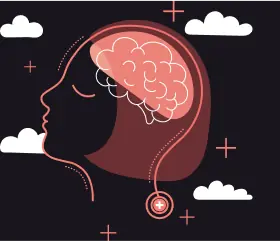The Science of the Chorus Relaxation Method
December 13, 2021

Meditation
Not only can meditation make us feel better, but with consistency it can literally strengthen our brains. Yep, that’s right, we can actually rewire the neural circuits and strengthen physical connections in our brains.
So, when you are meditating and feel control over your emotions, have an uplifted mood or positive outlook, you are actually training your brain how to do this in real life.
Numerous studies have found that meditation affects brain activity in some pretty awesome ways, including:
- Reduced perception of pain1
- Brain waves associated with feelings of calm become more pronounced2
- Improved attention and focus3
Scientists have concluded that meditation leads to these positive changes by improving how the cerebral networks in our brain function.4
Breath
But Chorus Sleep Sessions are not just traditional meditation. The Chorus Method incorporates controlled breathing, which assists in the regulation of our nervous systems.
Quick refresh, the autonomic nervous system is the part of our body that controls functions like heart rate, digestion, respiratory rate, pulmonary response and others. The autonomic nervous system is made up of two parts. First, the sympathetic nervous system, our fight or flight system, and second, the parasympathetic nervous system, our rest and digest system.
A common problem in modern life is that we are in a constant state of partial stress. That low buzzing of anxiety or subtle feeling of being on edge throughout our days, causing us to be irritable or impatient, struggle to focus, or have trouble sleeping isn't just bad for our mental well being, it’s bad for our physical health as well.5
Good news, breathing can help!
By using controlled breathing, like we do in Chorus Sleep Sessions, we stimulate the vagus nerve and actively control our autonomic nervous system.
By breathing deeply and in a controlled manner, we intentionally turn on our sympathetic nervous system. This trains our minds to consciously access the nervous system, so we can control it. We turn up the sympathetic nervous system SO THAT we can turn it down and spend the rest of our days in a relaxed state of actual calm and no longer suffer from the chronic partial stress described above.
On the flip side, by breathing slowly and in a controlled manner, we intentionally turn on our parasympathetic nervous system, which reduces blood pressure, relaxes our body, and calms our minds.
The Chorus Method
So...how does all this factor into Chorus Sleep Sessions?
The Chorus Method combines traditional meditation and controlled breathing, with music and personal guidance to make it easier and more enjoyable to shift our nervous system to rest.
We do this by starting off with concrete and tangible objects to focus on (breath, beat of the music, teacher’s voice) so that when we move into the traditional meditation on the back half of class, our mind is actually able to enter a calm state vs. wrestling to get quiet. You know the feeling when trying to FORCE yourself into a relaxed state …yeah, we want to avoid that! 😉
You can think of the rhythmic breathing as the “warm up” for the relaxation portion of the sleep session. Just like a physical workout, the warm up loosens the body up and gets the blood flowing so when you try to relax, it’s more effective.
In this first part of class we harness the power of our breath, together with the music, to create space in our minds and bodies SO THAT we can effortlessly sink into that calm state we all love, and effectively relax our minds and bodies, by the end of the Sleep Session.
Oxygen is the energy source for every metabolic process in our body and is essential to brain function. As we practice controlled breathing, we move oxygen through our bodies in ways that improve brain and body functioning. Through this physical reaction, paired with relaxation, we create space in the mind so we can enter a restful state.
Adding Chorus Sleep Sessions to your bedtime routine, may help you fall asleep faster and unlock higher quality sleep throughout the night.
Whatsmore, with consistency, you may notice even more tangible benefits outside of sleep, like more control over your emotions, increased focus and productivity, and enhanced connections with loved ones.
Ready? Try the Chorus Sleep app today!
Footnotes:
- “Cortical thickness and pain sensitivity in zen meditators”, 2010, https://www.ncbi.nlm.nih.gov/pubmed/20141301
- “Brain waves and meditation”, Science Daily, 2010: https://www.sciencedaily.com/releases/2010/03/100319210631.htm “Increased Theta and Alpha EEG Activity During Nondirective Meditation”, 2009, https://www.liebertpub.com/doi/10.1089/acm.2009.0113
- “Mindful breath awareness meditation facilitates efficiency gains in brain networks: A steady-state visually evoked potentials study.”, 2018: https://www.ncbi.nlm.nih.gov/pubmed/30209327
- “The effect of meditation on brain structure: cortical thickness mapping and diffusion tensor imaging”, 2013, https://www.ncbi.nlm.nih.gov/pmc/articles/PMC3541490/
- Premier Health: “Beware High Levels of Cortisol, the Stress Hormone”, 2017, https://www.premierhealth.com/your-health/articles/women-wisdom-wellness-/beware-high-levels-of-cortisol-the-stress-hormone#:~:text=Cortisol%20narrows%20the%20arteries%2C%20while,may%20constantly%20pump%20out%20cortisol.